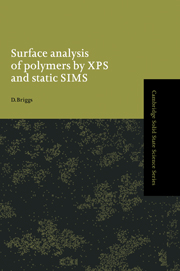Chapter 5 - Information from SSIMS
Published online by Cambridge University Press: 08 October 2009
Summary
There are inherent differences between the spectral features relating to polymers per se and the (usually) lower molecular weight species, such as contaminants and additives, which are often detected on polymer surfaces. It is, therefore, convenient to discuss these separately. Cationisation, deliberately induced or otherwise, leads to major variations in spectra from either class of material which are further discussed in Section 5.4. The identification of the atomic species from which either polymers or ‘small’ molecules are composed is, however, fairly straightforward.
Elemental identification
Most of the important elements in polymer surface analysis can be identified directly from peaks at the appropriate atomic masses. For high mass resolution instruments (i.e. m/Δm>3000) elemental peaks are resolved from interfering organic cluster ions and identification is either by exact mass measurement or by detection of the expected isotopic abundancies. This is particularly important for the detection of low concentration metallic species which give positive ion peaks of lower intensity than the interfering organic fragment ions from either the polymer or other organic species at the surface. Fig. 5.1 illustrates the detection of zinc at the surface of a poly(styrene) sample; this would not be possible with a low mass resolution instrument. The great majority of metals give exclusively positive ions under SSIMS conditions. The most electropositive elements, i.e. the alkali and alkali earth metals, give particularly high positive ion yields. Conversely, the electronegative elements, i.e. oxygen, fluorine, chlorine, bromine and iodine, give intense negative ion signals. Hydrogen gives both H+ and H- in high yield.
Carbon is detected as C-, although the accompanying CH- is always more intense. Nitrogen is not detected via an elemental peak. If the concentration is high enough (particularly if a low resolution instrument is used) the CN- and/or CNO- peaks are readily observed.
- Type
- Chapter
- Information
- Surface Analysis of Polymers by XPS and Static SIMS , pp. 119 - 155Publisher: Cambridge University PressPrint publication year: 1998



